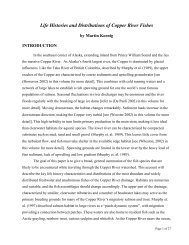Mitigation for the Construction and Operation of Libby Dam
Mitigation for the Construction and Operation of Libby Dam
Mitigation for the Construction and Operation of Libby Dam
You also want an ePaper? Increase the reach of your titles
YUMPU automatically turns print PDFs into web optimized ePapers that Google loves.
We compared samples collected in September 2000 (be<strong>for</strong>e <strong>the</strong> ULCC restoration)<br />
with samples collected in August 2003. Three samples were collected from separate riffles<br />
with a Surber Sampler (0.098 m 2 , 500-µm mesh), preserved in <strong>the</strong> field with ethanol <strong>and</strong> sent<br />
to EcoAnalysts, Inc. (Moscow ID) <strong>for</strong> analysis.<br />
We used <strong>the</strong> st<strong>and</strong>ard protocols <strong>for</strong> macroinvertebrate sample analysis, as outlined by<br />
Bukantis (1998) <strong>for</strong> <strong>the</strong> Montana DEQ. These protocols use a 300-organism subsample <strong>and</strong><br />
genus- or species-level taxonomic determinations <strong>for</strong> all organisms. Occasionally specimen<br />
condition or maturity prohibited taxonomy to <strong>the</strong> species level, <strong>and</strong> taxa were identified to<br />
family or genus only.<br />
Rapid bioassessment protocols (RBP) <strong>for</strong> Montana compare biological metrics from<br />
study site to a population <strong>of</strong> regional reference sites located throughout <strong>the</strong> state. The original<br />
framework was developed by Bahls et al. (1992) <strong>and</strong> modified by Bukantis (1998), Bollman<br />
(1998), <strong>and</strong> Marshall <strong>and</strong> Kerans (2003). We used <strong>the</strong> metrics recommended by Marshall<br />
<strong>and</strong> Kerans (2003) <strong>for</strong> <strong>the</strong> assessment <strong>of</strong> mountain streams in Montana because statistical<br />
power analysis indicated <strong>the</strong>se metrics were sensitive to environmental changes.<br />
It is important to note that RBPs <strong>and</strong> <strong>the</strong>ir regional reference criteria are not scaled to<br />
assess local-scale or reach-scale ecological changes. Fur<strong>the</strong>rmore, <strong>the</strong> field collection<br />
methods used by an RBP design use different techniques <strong>and</strong> are not replicated. There<strong>for</strong>e we<br />
used a simple replicated statistical design to test <strong>for</strong> differences be<strong>for</strong>e <strong>and</strong> after restoration.<br />
To avoid ethical problems with data-snooping, we selected <strong>the</strong> metrics prior to analysis. We<br />
included <strong>the</strong> metrics recommended by Marshall <strong>and</strong> Kerans (2003) because <strong>the</strong>y have been<br />
successfully used in Montana mountain streams. We also used several o<strong>the</strong>rs that have<br />
historically been used in Montana that summarize different kinds <strong>of</strong> in<strong>for</strong>mation. We used<br />
<strong>the</strong>se metrics because <strong>the</strong>y summarize portions <strong>of</strong> <strong>the</strong> community <strong>and</strong> provide indicators <strong>of</strong><br />
community function.<br />
The metrics were included Taxa Richness, EPT index (e.g., , Contribution <strong>of</strong><br />
Ephemeroptera, Plecoptera, <strong>and</strong> Tricoptera-taxa), Simpsons Diversity (D), <strong>the</strong> Ratio <strong>of</strong><br />
Baetidae: Ephemeroptera, <strong>the</strong> Contribution <strong>of</strong> Diptera, <strong>the</strong> proportional abundance <strong>of</strong><br />
burrowers <strong>and</strong> sprawlers (sediment tolerant), <strong>and</strong> <strong>the</strong> contribution <strong>of</strong> collector-ga<strong>the</strong>rers. The<br />
metrics were compared using two-sample t-tests. The critical level <strong>of</strong> alpha was kept at 0.05,<br />
following <strong>the</strong> conventions <strong>of</strong> modern ecology.<br />
The Grave Creek Phase I Restoration Project<br />
Montana FWP entered into a cooperative agreement that was coordinated through <strong>the</strong><br />
Kootenai River Network to retain a consultant to develop <strong>and</strong> implement a restoration plan<br />
<strong>for</strong> approximately 4,300 feet <strong>of</strong> channel within <strong>the</strong> lower three miles <strong>of</strong> Grave Creek (WCI<br />
2002). Additional contributors to <strong>the</strong> project included Montana Department <strong>of</strong><br />
Environmental Quality, <strong>the</strong> National Fish <strong>and</strong> Wildlife Foundation, <strong>the</strong> Steele-Reese<br />
Foundation, <strong>the</strong> U.S. Fish <strong>and</strong> Wildlife Service (Partners <strong>for</strong> Wildlife Program), <strong>the</strong> Montana<br />
Community Foundation, <strong>the</strong> Montana Trout Foundation, <strong>and</strong> <strong>the</strong> Cadeau Foundation. The<br />
project is termed <strong>the</strong> Grave Creek Phase I Restoration Project, <strong>and</strong> begins at <strong>the</strong> downstream<br />
end <strong>of</strong> <strong>the</strong> Grave Creek Demonstration Project (see Dunnigan et al. 2003). Stream<br />
restoration work began <strong>and</strong> was completed during <strong>the</strong> fall <strong>of</strong> 2002. Numerous structures<br />
were installed including 12 rootwad composites, 11 debris jams, 8 log J-hook vanes, 4 cobble<br />
46
















